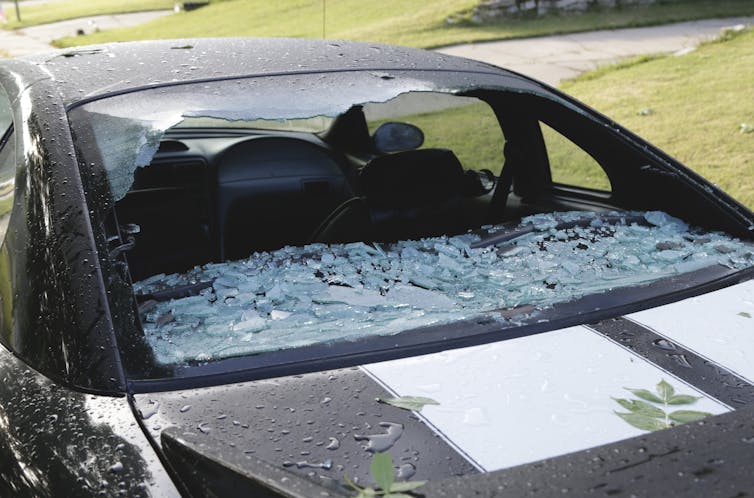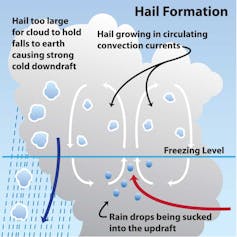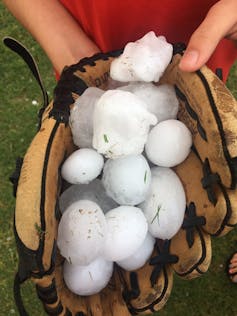Editor’s note: Samuel Childs, Ph.D. student in Atmospheric Science at Colorado State University, wrote this piece for The Conversation in September 2018. Colorado State is a contributing institution to The Conversation, an independent collaboration between editors and academics that provides informed news analysis and commentary to the general public. See the entire list of contributing faculty and their articles here.

As ominous skies moved overhead just after noon on Aug. 6, the small splash of a hailstone was heard in the pool of the bear exhibit at the Cheyenne Mountain Zoo in Colorado Springs. Moments later, a barrage of ice baseballs began falling from the sky, with one or two softball-sized hailstones in the mix. People and animals scrambled for cover.
Insane video of baseball size hail hitting the bear exhibit at Cheyenne Mountain Zoo this afternoon. Such a scary situation for all of the people and animals involved. Video credit: Christine Barkalow #cowx pic.twitter.com/LeC1tKzkb9
— Jessica Lebel (@JessicaLebelWX) August 7, 2018
In the aftermath, the hail storm’s wrath was revealed: at least eight people injured, five animals killed and hundreds of cars severely damaged in the zoo parking lot.
Whether you’re a farmer managing hundreds of acres of corn, a school teacher in care of young children at recess, or an unsuspecting tourist excited to watch the dolphin show, hail storms matter. This summer’s Colorado Springs event is yet another reminder of the destruction that large hail can bring. These large hail events seem to be more and more common, which has prompted atmospheric scientists like me to investigate trends in hail storms, as well as other severe weather phenomena. A better scientific understanding of hail storms can help increase public awareness, including of how best to protect one’s life and property.
A record-setting year

Hail is precipitation that falls in the form of ice. In basic terms, hailstones form as water is lofted into the upper cold regions of a thunderstorm, where it freezes. Supercooled liquid water at these heights can continue to add mass to a small hailstone – eventually it becomes too heavy and falls out of the cloud.
The largest hailstones are found in strong thunderstorms, called supercells, which have sufficiently strong updrafts to allow hailstones to reach the ice region of the cloud, thus acquiring more mass before falling out. Supercells, and thus large hail, are aided by warm and moist conditions that promote strong, juicy updrafts and also a wind field that strengthens and turns with height.
For anyone living in the Great Plains, this year has been a hail season to remember, with many more large hailstones being reported than usual. Neither the total number of severe hail reports – defined by the National Weather Service’s Storm Prediction Center (SPC) as hail in excess of 1 inch in diameter – nor the number of days in which severe hail has fallen, were out of the ordinary. But in 2018, the percentage of hail greater than 2 inches in diameter certainly was.
Here in Colorado, over 20 percent of severe hail reports through the beginning of September have been at least 2 inches. Three percent have been at least 3 inches – bigger than a standard 2.75-inch baseball. These are the highest such percentages in state history. Moreover, Colorado saw a new record, with hail greater than 3 inches in diameter reported 10 times, over seven different days.
And these trends hold nationally, too, according to preliminary SPC reports. Across the country, percentages of large hailstones are among the highest seen since the turn of this century. Geographically, very large hail reports for 2018 stretch from Idaho to Florida to Connecticut, with a maximum in the western Great Plains.
So what’s going on?
A new normal?
Having an increasingly higher proportion of large hail is not an encouraging trend for home or automobile owners.
The SPC hail database is the country’s primary source of hail reports. They come from a variety of sources including trained spotters, meteorologists, law enforcement and the general public. As such, the database has some inherent reporting biases. For example, reports tend to cluster around places where people live. And people tend to report hail of sizes they associate with common objects, such as golf balls or baseballs.
But it’s hard to believe people are suddenly becoming more excited to report only large hail, while ignoring the quarter-sized hail that can still be a nuisance. In fact, this year may be a hint of what will become commonplace in the future.
Effectively simulating the growth of hail in a model is nearly impossible due to the intricate microphysical processes involved. Imagine the difficulty of trying to account for hail’s erratic wobbling and tumbling within a cloud and the constant addition and loss of water on its surface. As icing on the cake, each hailstone has a unique shape, and it’s hardly ever spherical. Nevertheless, it is possible to look at changes in variables that are important for hail growth.
Recent research assessed the effects of climate change on hail size and frequency using a hail growth model with environmental variables adjusted for climate change. The relatively cool and dry Plains region is expected to become warmer and more moist in a future climate, leading to stronger updrafts and more moisture availability. Under these conditions, scientists found that both average hail diameter and frequency of large hail occurrence are expected to increase across the central part of the country.
Researchers at the National Center for Atmospheric Research have found that in a future climate, there will be more strong thunderstorms and fewer weak ones. This result again favors an increase in larger hailstone sizes, since stronger thunderstorms allow the hail to be cycled through the cloud layer for a longer time.
Untangling what drives the trend

Is a changing climate all that’s responsible for what appears to be a shift toward storms with greater hailstone sizes that occur more frequently? What about population dynamics and urbanization? After all, hailstones can only be reported where people are around to measure them.
These questions have prompted my current research that aims to differentiate the relative contributions from climate change and population change to future hail storm risk. I’m combining a weather model that projects future changes in variables that promote hail storms with spatial population projections from NCAR and the EPA. The goal is to assess where and how much the greatest human risk from large hail is expected to be in the future.
Compared to tornadoes and hurricanes, large hail has received relatively little research attention, but that’s starting to change: A major international workshop was held in August 2018 to share research ideas and results. Achieving better understanding of how hail storms might look in the future, and which places might become more at risk, is of great worth for decision-makers, the insurance industry and the general public. Hopefully, such knowledge will spare everyone – including vacationing families at a popular zoo – the nightmare of dealing with destruction by softball-sized hail.
This article is republished from The Conversation under a Creative Commons license. Read the original article.
![]()